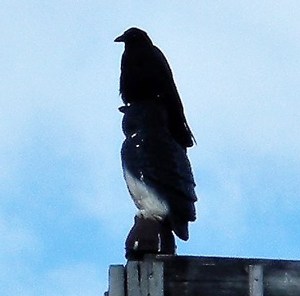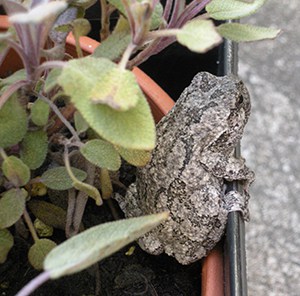Rob Danforth
There are many critters that can affect your gardening satisfaction – I have had them all: deer, skunks, raccoons, voles, mice, dogs, cats, birds, rabbits, chipmunks, ground hogs, rats, and squirrels! Also bats, tree frogs, toads, snakes, and hawks.
Tip: it is best to work with nature than against it. A war with nature only leads to frustration and disappointment – and maybe high blood pressure! Critter damage can be very annoying; however, usually the damage can be cut away and the produce salvaged.
Below, left: Fearless crow; right: Canadian Tree frog
SQUIRRELS are excellent climbers that like to sample many vegetables, seeds, flowers and bulbs. Specialists in decapitating sun flowers and tulips, and in planting peanuts in lawns, beds and pots. A squirrel once ran off with an entire kohlrabi plant – dragged it up and over the fence! Deterrents: complete enclosure of chicken wire or bird net; dog hair or a dog; plastic net bags encasing squash and melons; light spray of soap on fruit, cayenne pepper or garlic on produce; sprinkled blood meal (re-apply soap, cayenne, garlic, or bloodmeal after rain); rubber snake or a short length of garden hose fashioned as a snake (be sure to move it regularly or it will be ignored); and anti-critter spike mats, river stones, and stainless-steel pot scrubs as soil covers.
CATS – Tomcats mark territory with spray that burns vegetation and cat poop has pathogens dangerous to people. Scoop the poop and the soil around it – do not compost. Deterrents: leaf mulch, firm packed soil, old rose canes, anti-critter spike mats, smell dissuaders, and respectful chat with neighbourhood cat owners.
DOG urine burns vegetation and dog poop has unhealthy pathogens and parasites that can remain in the soil for years. Scoop the poop before it rains (soil does not need scooping) – do not compost. Deterrents: 4 to 5-foot chicken wire fence, plant containers, motion sensors with sprinkler, smell dissuaders, designated pee post, and respectful chat with dog owners.
CHIPMUNKS – Climbers that may burrow into your box bed, and they love sunflower seeds! Deterrents: chicken wire, dog hair, row covers, or hoop tunnels – and sacrificial sunflowers.
Below, left: Mouse; right: Snap traps for mice (left and rats (right)
GROUNDHOGS are great climbers that enjoy leafy greens. Deterrents: full hoop enclosure (not a fence) of chicken wire; blood meal, cayenne pepper, human hair, dog hair (or a dog), old rose canes; human urine or full-strength household ammonia down the hole. Landscape fabric at the bottom of our cold frame stopped a ground hog from completing a tunnel – twice!
RABBITS eat a little here & there at dawn, dusk and on cloudy days. They are not voracious but do have favourites and may nest under shrubs. Deterrents: used coffee grounds, human hair, dog hair (or a dog), blood meal (dusted or bagged), and chicken wire. Distract them with Dutch White clover in the lawn. The good news is they do not climb so containers are a good choice. Caution: some rabbits seem to see dogs as protection rather than a deterrent – those near us certainly do!
Tip: Dutch white clover in the lawn will add nitrogen to the soil and attract rabbits and bees. This clover is a good lawn cover if grass is a problem (we use it to recover lawn from chinch bug). Note: when it flowers, time to mow.
DEER will enjoy your beans, squash, zucchini, and leafy greens. According to the hoof prints and the jaw marks on the ¼ inch of butternut squash rind that remained on the ground, a large deer(s) ate 95% of one of our butternut squashes as well a few zucchinis and all my beans. Deterrents: 8-foot fence; pleated, springy chicken wire as ground cover; strongly scented herbs (garlic, rosemary, thyme, oregano, mint etc.; human hair; rotten eggs (not fun for people either); garlic or soap spray on produce (not leaves); bar of Irish Spring soap or fragrant dryer sheets.
Caution: If you try the soap or dryer sheet deterrents, protect them from rain and keep liquid run-off from getting into the soil (e.g., put soap or dryer sheets in a recycled can – it is the strong smell that is the deterrent).
Below, left: Live trap; right: Two types of hardware cloth
BIRDS are a problem only if you have berries or seeds to protect. Deterrents: scarecrow (must have moving parts); bird netting; old CDs or tin foil pans dangling (not very effective for our garden!); plastic raptor or raptor kite on a tether attached to a flexible pole, fly fishing rod, or whip antenna (this kite flies whenever the wind blows).
- Plastic raptors (owls & hawks) will discourage all birds and may not be the solution you want! They too must be moved about from time to time or birds will perch on them.
- Many birds eat bugs, especially when feeding their young, so cover seeds, berries, and currants with plastic netting (green or black) draped over the bush or spread over a hoop or a bamboo frame. This lets birds get at the bugs in the rest of your garden.
MICE are a problem in homes, storage areas and garden sheds where urine, poop, chewing, nesting and Hantavirus (in dust from dried poop) all pose problems. Deterrents: hardware cloth (actually a wire mesh of ½ or ¼ inch squares); snap traps; non-chewable containers with tight lids for storage of seeds, bulbs, string, cotton rope, and fabrics that can be used as nest material; mint; rubber snake (moved occasionally).
- Hantavirus in dry mouse droppings makes people sick. Do not breathe the dust! Wear a mask when cleaning up dried mouse poop.
- Plastic, canvas, or tarp bags are not mouse-proof. Tip: recycled food buckets with lids store chewable items safely and also make great garden work seats for senior gardeners.
- Live traps are available but not recommended – if you live-trap, monitor often as a mouse will perish in a very short time – even overnight. Plan your relocation site and have hand sanitizer nearby.
VOLES are larger than mice but smaller than rats, with short tails, and move at light speed. When I disturbed a neighbour’s pile of straw mulch, there was a starburst of voles rushing to all points of the compass. They are very prolific breeders, do not hibernate, and come in cycles of 2 to 5 years. Voles eat greens and roots. Watch for holes roughly the size of a golf ball. Deterrents: reduce hiding places such as open piles of compost, garden debris, mulch; hardware cloth to 6 inches under soil and 6 inches above; plants from the onion family, daffodils, grape hyacinth (aka “muscari”); baited snap traps; rubber snake moved about; castor oil sprayed or household ammonia on cloth/cotton ball stuffed in hole. Tip: household ammonia is very like human urine. If you have no ammonia handy, perhaps a pee nocturnally?
RATS are omnivorous creatures and will eat almost anything in your garden or composter including vegetables, bugs, and dead creatures. They can easily chew through wood or plastic to gain access, so look for access holes. Deterrents: Keep composters closed, aerate (stir) often, do not put cooked food in the composter; keep garden areas clean and visit frequently – rats do not like your company! If you find a hole, use a snap trap (rat sized – larger than a mouse trap) and bait it with peanut butter. Tip: there are new traps available that open from the back like a clothes peg so you do not have to touch the dead creature as you empty the trap. However, gloves are recommended as well as hand sanitizer for the gloves (not the trap).
RACCOONS are intelligent, nocturnal, urban residents with very regular habits. They are excellent climbers and may break into your composter, green bin, or attic. Raccoons will learn to push lids off composters and to knock over green bins so they spring open. They eat bugs, food leftovers (chicken is a favourite), and all your corn! Raccoons climb a corn stalk until it topples over, and then strip the cobs bare of kernels. Deterrents: electric fence; full enclosure (not a fence) of chicken wire; aggressive dog; motion sensor with sprinkler, lights or noise makers; human or dog hair; human urine. Nematodes can be used to control lawn grubs which raccoons enjoy. Tie down composters with bungee cords and secure green bins so they can’t be knocked over, and don’t grow corn!
SKUNKS leave their den in the evening, follow a regular itinerary through the neighbourhood looking for food, and return to the den at dawn. Skunks do not smell bad unless they spray when threatened. They are only a problem for the bugs in your compost and lawn – and maybe for your dog! Deterrents: fence along decks, porches, and sheds to block access; keep compost and pet food secured; install motion sensor lights or sprinklers; add marigold garden borders; use nematodes to kill grubs in your lawn, thereby removing skunk food.
- If you can tolerate a skunk, leave it be! A skunk digs holes in my lawn to eat Japanese beetle grubs.
- If they nest onsite, block the hole at night after they leave to forage.
- Note: skunks and raccoons will overturn fresh sod in their search for bugs and grubs. You may need to use a bird netting or chicken wire sod cover.
Helpful wildlife includes owls, hawks, bats, toads, snakes, and Canadian tree frogs.
 A water feature helps predatory insects, birds, and critters in your garden. Our fountain is very popular – birds line up on the fence to take turns bathing in the top bowl! Some birds (esp. robins) are reluctant to leave, and we’ve seen crows wash food in the water. Birds, critters, insects… all need water.
A water feature helps predatory insects, birds, and critters in your garden. Our fountain is very popular – birds line up on the fence to take turns bathing in the top bowl! Some birds (esp. robins) are reluctant to leave, and we’ve seen crows wash food in the water. Birds, critters, insects… all need water.
Special Note: live trapping and re-locating seems like a humane solution but is not recommended! (see Ontario Fish and Wildlife and the Humane Society on-line).
- Ontario advises you that it is illegal to re-locate live animals beyond one kilometer from where they are caught.
- Re-locating animals may condemn them to death since they must re-establish themselves concerning food, water, shelter, territories, and neighbours (friends & enemies).
- Trapping and re-locating a parent may leave babies to starve to death or wander unprotected and untrained as orphans.
- Years ago, a neighbour tried to live trap a ground hog and caught a skunk – and was totally unprepared for what to do next.
Caution: Animal poisons have no place in an organic garden. Such poisons around food and children are a very bad idea, and poisoned critters may hurt those animals that eat them. Someone had poisoned a neighbourhood ground hog and I saw it minutes before it died in the street. The poor creature’s misery was an unforgettable horror to witness.
In most cases, physical barriers are a good, humane solution. Hoops or frames allow for a variety of covers: poly tunnels, bird/squirrel netting, bug netting, sun screens, row covers, and chicken wire. Bamboo rods and zip ties make a quick and sturdy rectangular frame or A-frame to support covers. Hardware cloth above and below ground keeps out rodents. Buried landscape fabric, hardware cloth, and chicken wire can deter burrowing.
Knowing your critters and their habits can give you ways to manage them rather than eliminate them. Whatever the challenge, keep calm and carry on gardening!





